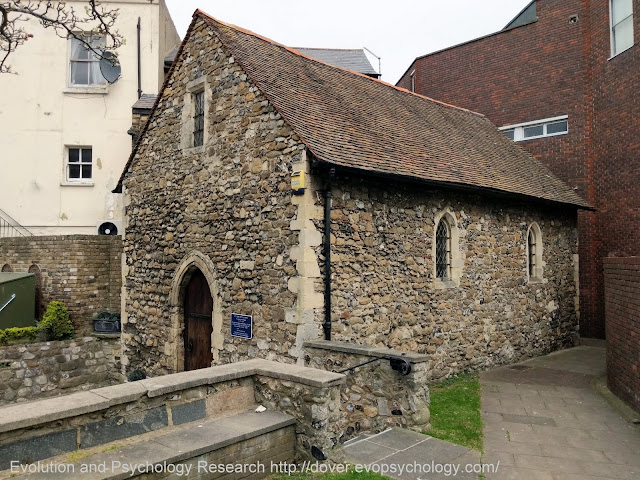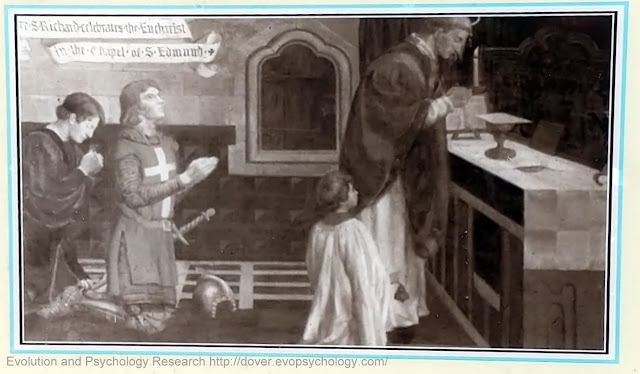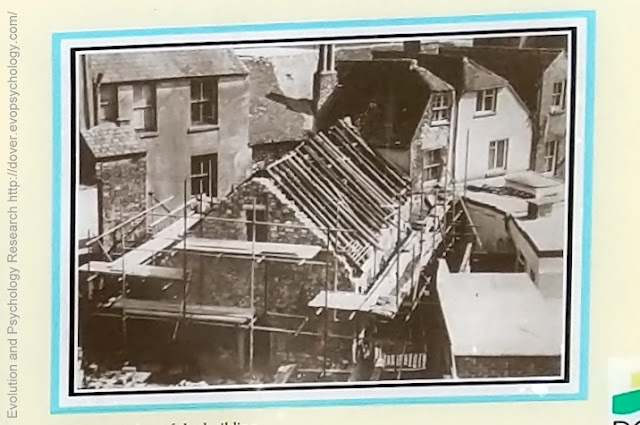 |
| The path on the right is "St Edmund's Walk" and leads to the Biggin Street shopping precinct. |
Hidden for 400 years, the chapel was restored to public view during the Second World War following a German artillery bombardment in 1943 that demolished two of the surrounding buildings (one of which was "Bicknell's", H. R. Bicknell, a newsagent and tobacconist, also of Priory Road).
This 13th century building, some 28 feet by 14 feet, is the only chapel dedicated by one English saint, St Richard of Chichester, to another English saint, St Edmund of Abingdon (Edmund Rich, or Edmund of Canterbury, consecrated as Archbishop of Canterbury on 2 April 1234):
 |
| Extracted from information plaque: "St Richard celebrates the Eucharist in the Chapel of St Edmund." |
St Edmund's Chapel, built in 1253, is now a Listed Building and originally belonged to the Maison Dieu, which ministered to pilgrims, and was under the control of a Master appointed by St Martin's Priory, then the most important institution in the medieval town except for Dover Castle.
A 'Cemetery of the Poor' had been established outside the Priory and the Town Walls, and the chapel was built in its grounds, probably as a Chapel of Rest,
It was consecrated in 1253 by Richard, Bishop of Chichester, in the name of Edmund, a former Archbishop of Canterbury under whom Richard had first studied and who was canonized in 1246:
Richard fell ill and died in the Maison Dieu only 4 days later. Before his body was returned to Chichester Cathedral for burial, his internal organs were removed and buried in a Cist, or pit, under the Chapel altar. This Cist, now empty, can still be seen.
When Richard was canonized in 1262. St Edmund's Chapel became a place of pilgrimage in its own right. It is still the only church in existence that was dedicated to one English Saint by another.
After the Reformation in 1534. the Priory, the Maison Dieu and St Edmunds were forced to close. The chapel was surrendered to King Henry VIII in 1544 (Dissolution of the Monasteries).
Over the years, new buildings concealed the old chapel and its sacred status was forgotten.
It had many uses including, in late Victorian times, use as a blacksmith's forge.
In 1965 Father Tanner, Dover's Roman Catholic Parish Priest, arranged for both the private purchase of the chapel and its restoration, using only genuine medieval materials - at least 75% of the building is original however:
 |
| Extracted from information plaque: "1965 restoration of the building" |
The Chapel was re-consecrated in 1968 and is now owned by a charitable trust who maintain it solely from gifts placed in the wall boxes.
A nighttime photograph of St Edmund's Chapel that was taken on the 8th of January 2011:
Extract from "The History of the Castle, Town and Port of Dover" by Reverend S. P. H. Statham, Rector of St Mary-in-the-Castle (Longmans, Green, and Co., 1899), page 209:
A Wayside Chapel
The remains of a very interesting thirteenth century chapel are still to be seen hemmed in by the shops in Biggin Street and Priory Road. It is a small building some twenty-eight feet in length by fourteen broad.
The walls, which are fairly intact, are built of rubble masonry two feet thick, with Caen stone quoins and dressings. The west doorway is plain pointed with roll mouldings.
The north and south walls are pierced by two lancet windows each, widely splayed, and a moulded string course ran round the interior below their sills. The roof was of a good pitch, and had tie-beams, collars and struts.
The chapel is now entirely given up to trade purposes and is difficult of access.
We conjecture that it was erected by the canons of St. Martin's and St. Mary's Priory, and was used as a wayside chapel, although it is not impossible that it may be the remains of the Hospital of St. Bartholomew's Chapel.
In addition to once being a victualling store for the Royal Navy, a store room, and a blacksmith's forge, prior to the 1965 restoration St Edmund's Chapel was also a Talbot House (Toc H) meeting place.
Internal views of St Edmund's Chapel can be seen in the photo section of the St Edmund Of Abingdon Facebook page.
The main (first) photograph was taken on the 6th of April 2020 during a permitted Coronavirus bike ride.
Covid-19 lockdown: a cycling route map and biometrics can be seen on this Polar Flow web page.
Abridged versions of this post are also on Facebook and Twitter.
(1) From St Edmund's Chapel

No comments:
Post a Comment